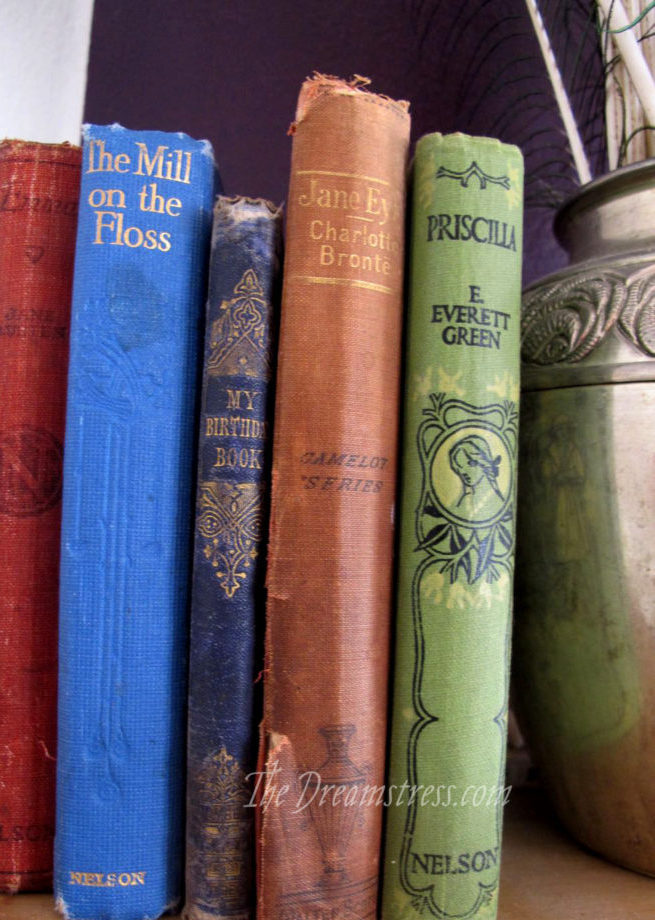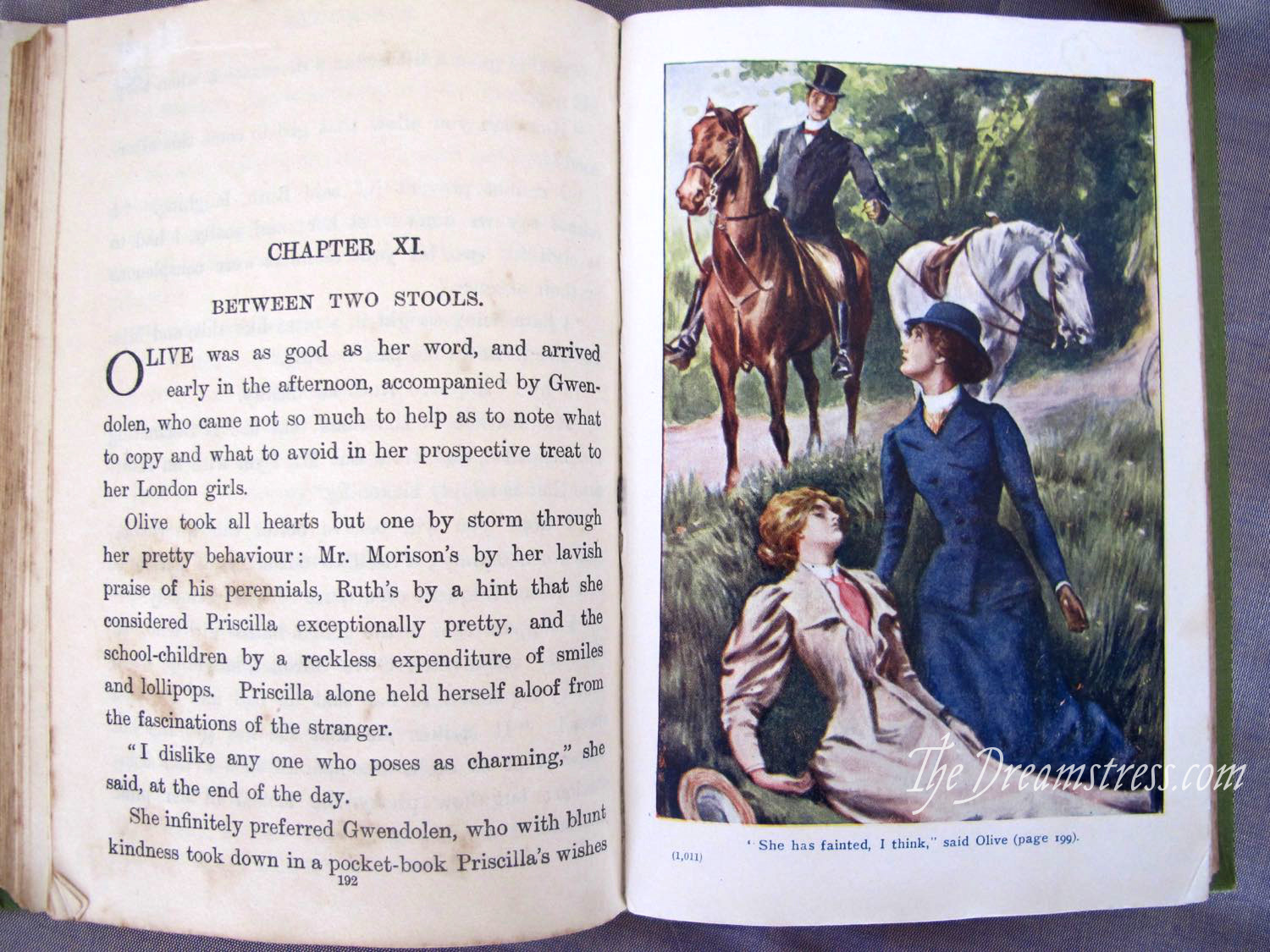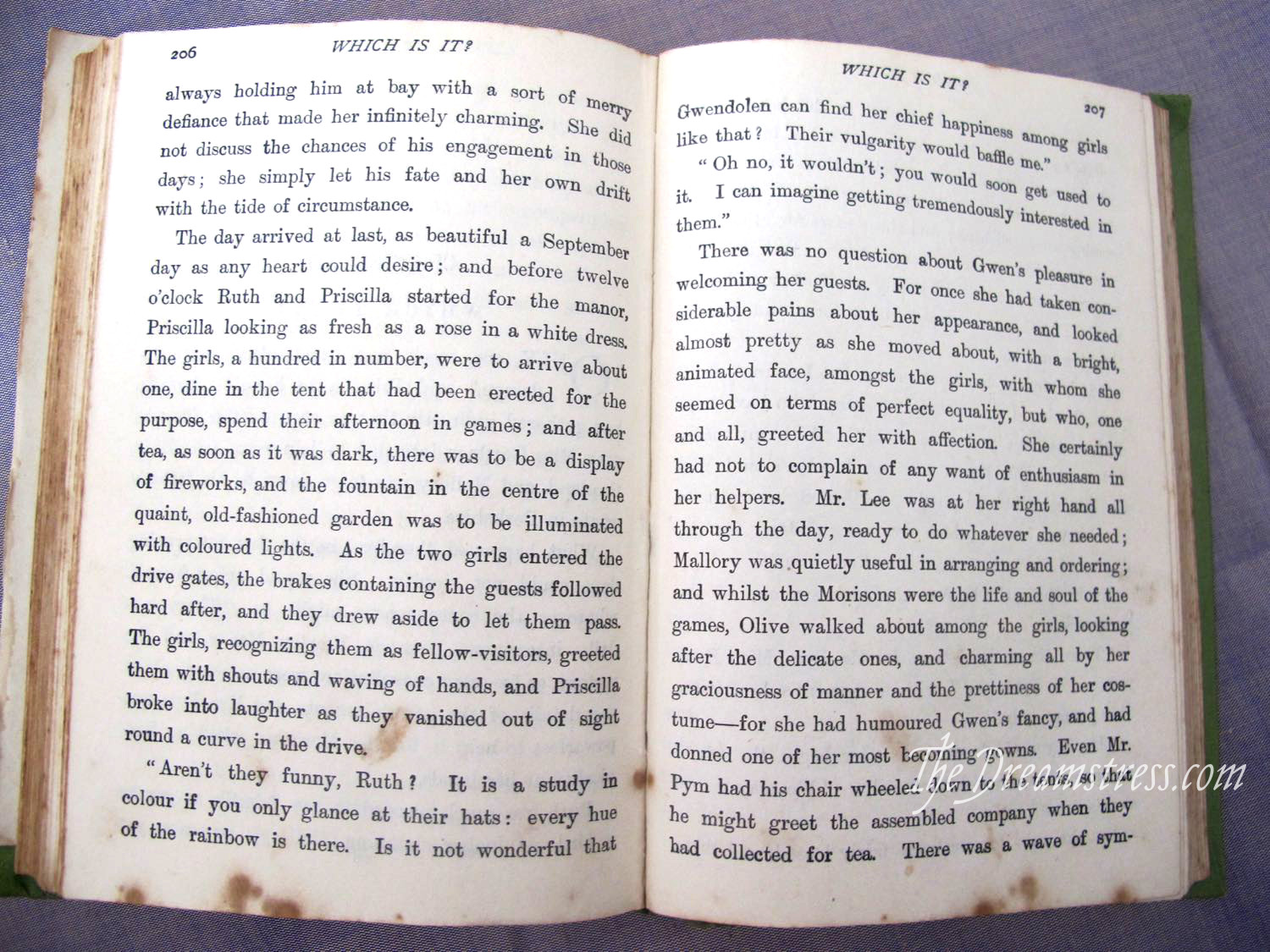I started this post for May’s Historical Sew Monthly theme of ‘Literature’, but due to my arm injury I wasn’t able to finish it during May.
So, a little late, because I’m still on doctor enforced limited-computer time, a historical book review for a very fun piece, full of costume descriptions and illustration.

Priscilla is an 1890s romance novel by E Everett-Green, a prolific writer of ‘pious and improving’ stories for girls, as well as historical novels (and daughter of the truly amazing Mary Anne Everett Green). Knowing Everett-Green’s reputation for moralistic literature, Priscilla surprised me.
Despite the titular Priscilla dominating the plot, the book is not really about her: it’s a picture of six possibilities of late-Victorian womanhood; archetypical ingenue Priscilla; her sister Ruth, the pattern card of the ideal 19th century wife, sister & daughter, in a style that was already a bit old-fashioned for the 1890s; spinster cousin Barbara Stillingfield, grown cold and warped with stifled love and hope; petted and fete’d society beauty Olive Gardner; society matron Mrs Pym; and Gwendolyn Pym, firmly focused on the possibilities beyond the bounds of acceptable 19th century feminine pursuits.
The central story (Priscilla’s) is pretty standard Victorian (or any era) romance: a meet-cute followed by opportunities for relationship-building slightly outside the societal norm, an obligatory save-her-life moment, and the the realisation of ‘Oh no, we’re in love! But society/family obligations says it should not be’. Attempts to un-fall-in-love, momentous occasion throw lovers together, much angst, more angst, hand wringing, yet more angst, annnnnnnnnnggggggggggst. Oh yay, the course of true love reaches its conclusion!
(No spoiler warnings, because you already know how that plot goes).

Priscilla’s story, is, in short, boring. Priscilla is also boring, and to honest, a bit of a tiresome brat. She may be “a dainty little creature in a simple white cotton frock, with speedwell-blue eyes, a wild-rose complexion…”, but the very first thing she does is to fling the book her sister Ruth is reading, on to the ground in a petty tantrum.
Treating books badly is not a good way to get people who like reading books (which, presumably would apply to anyone reading about said book-hurtling) on your side!
And Priscilla doesn’t improve much. She grows up a little bit, does a bit more to help out, but she’s still the only young character in the book to behave in a petty, jealous, competitive manner – which does little to earn her the proper title of ‘heroine’ in a book that is otherwise free of the typical ‘catty female’ trope.

Interestingly, the most character-building thing that Priscilla does is to learn to ride a bike. The bike is a reward she earns through being helpful, and which she uses to be of further help in her district. It’s a notable choice of symbolic personality growth for its period: bike riding was still a contentious activity for women in the 1890s, and was not considered ladylike in many circles. The appropriateness of Priscilla riding is a point of much debate in the book. As late as 1907 the Girl’s Own Paper, for which Everett-Green wrote stories, warned against bicycle riding as a ‘man-game that murders beauty’ because it ‘rolls the spine, interferes with the proper function of the hips, and gives the bicycle face, with its ‘blintering eyes’, look of deep concern, square jaws, and flabby mock turtle cheeks'(!). In the context of the book’s time, Everett-Green’s choice of a bicycle to move Priscilla from a selfish child to a helpful adult is almost subversive.
There are other hints that all is not what might be expected in a late Victorian morality tale. Pattern-card of propriety and morality Ruth’s choices of self-sacrifise on the alter of family duty is called into question by the saintliest character in the book – and many others. Ruth is following the accepted paths of action for an eldest daughter by 19th century standards of virtue, but it is made quite clear that she may be misstepping, and is wrong to be ‘throwing away happiness’ for ‘a fancied duty’. Rich society belle Olive Gardner, who has long expected to marry the hero, and who would be jealous and conniving in any other story, is instead sweet, kind, open minded, generous spirited enough to immediately acknowledge Priscilla’s beauty, and has no interest in a rivalry with Priscilla. And spinster Barbara, derided by Priscilla as ‘hard, self-contained, and reserved’, is ultimately treated with sympathy – given a reason for her temperament, and a happy ending to her story.
Priscilla is a romance novel, so everyone gets a happy ending, but some are more unusual than others, and the most profoundly unexpected happy ending belongs to Gwendolyn Pym.
Gwen has no beauty, no desire for wealth, or a society marriage. Instead, her passion is for helping factory girls, for working to advance women’s rights – and particularly working women’s rights. Gwen wants ‘to do good to my kind – to spend my whole life in trying to lift the burden off people who have never had a chance of being decently happy or respectable.’
On the surface, Gwen’s aspirations aren’t that far off mainstream expectations of women’s behaviour for her period. If you can’t be a wife and mother, serve the world. However, how Gwen chooses to do it is quite amazing, and controversial, and why she chooses the path she does is even more amazing.
Gwen is presented as possibly the most admirable and moral character in Priscilla, but it’s also made clear that she does not believe in God (!) and considers herself an agnostic – a radical departure from the norm for the time (and there is also the definite hint that Gwen is totally uninterested in men, thought this shouldn’t necessarily be interpreted as her being lesbian in the modern sense, as the societal constructs around sexuality were totally different*). She also ultimately chooses her duty to the women she helps over her duty to her family, and explicitly states this bold choice. On being informed of this, Gwen’s mother, self-focused Mrs Pym, wails that she will ‘become a woman agitator…speak on platforms, or sit in vestries, or do any of the atrocious things that are turning good women into bad imitations of men nowdays?’ Gwen’s response is that ‘none of those things seem dreadful to me if one could be of service to one’s kind’, and you get the very firm idea, in reading it, that the author agrees, and that you, as the reader, thinking you were getting into a frothy romance, have suddenly been given a very firm dose of 19th century feminism, and have even been introduced to the radical concept that morality and religion are not the same thing.
Priscilla was a surprise to me, having read other Everett-Green works, and knowing her reputation as a clergyman’s daughter, and an active member of the Anglican church. I expected a standard tale of sweet-femininity and standard-virtue winning fair (*cough* and rich) gentleman, but I was also show a ‘mannish’, independent, brusk, untidy, totally uninterested in standard manners, and, as presented by the author, aspirational heroine – albeit one who had to be slipped into the story sideways.
It was a good reminder that no matter what our perceptions of the past, there was almost always a broader range of ideas and pattern cards to follow available.

Sadly, I haven’t managed to find a copy of Priscilla on any of the out-of-copyright publishing sites on the internet (Project Gutenberg, etc.), but if you can get your hands on it, I thoroughly recommend it. It’s still a standard Victorian novel in many ways, but in the small ways it steps out of the mould, it’s quite amazing and eye-opening.
*It may be of interest that Everett-Green lived with a female companion for most of her adult life, though I can’t find anything on what form that companionship took – it might very well have been simply a friendship.


“though this shouldn’t be interpreted as her being [a] lesbian” – but there is also no reason not to. Although social attitudes towards being gay were different, there’s no reason (and no evidence) to then pretend they therefore didn’t exist. Modern and historical lesbians are excluded, diminished and ignored enough. It is simply not good enough to think this is anything other than homophobia that made you feel the need to write that; you cannot pretend to be an ally if you then treat us as something weird different and highly unusual.
Before you try and tell me I am over-reacting, I would like you to first imagine that other people consider your identity so inherently repulsive that they will go out of their way to say there’s no way a historical or fictional figure could be anything like you.
Please make sure this is a habit you get out of, and do better in the future.
Let me get this straight? (no pun intended)
You’ve mis-quoted me, cut out the important part of the quote: ‘in the modern sense’ and are raking me over the coals, simply for pointing out that we don’t know what the author’s intentions were so shouldn’t make judgements about a fictional character, in a book you haven’t even read?
I’ve featured and discussed many amazing actual historical women in this blog who were, from everything we know about them, not heterosexual. I don’t believe in any way that we should write a diversity of sexuality out of history.
However, when we have very little evidence to go on, I also don’t think we should jump to conclusions. Perhaps Everett-Green imagined Gwen as asexual (a group that is honestly, overlooked and written out of history far more than gays). By pointing out that the Victorian framing of sexuality, particularly for women, was more complicated than a simple gay/straight dichotomy, I actually hoped to encourage readers to explore the other options on the spectrum of Victorian sexuality. By their standards (at least for women, at least if they kept an outward appearance of fitting into society), we’re actually pretty repressive. By saying we shouldn’t necessarily imagine Gwen as lesbian, I intended to give her more options, and NOT to give her a label, which for many people, will colour and pigeonhole her character.
By the way, you’ve jumped to conclusions about my sexuality based on the fact I’m married to a man. You should never jump to conclusions about anyone’s sexuality. Please make sure this is a habit you get out of, and do better in the future.
*applause*
Thank you for reminding everyone that pigeonholes are only good for pigeons!
~a modern lesbian who appreciates that interesting women exist all through history and that sexuality isn’t always the most interesting part!
Thank you! I’m very glad to know (and reassured) that I haven’t offended everyone who isn’t ‘straight’ and that there are other people who also think it’s not helpful to pigeonhole, and that sexuality isn’t always the most interesting thing about a person! (though I do agree with Ella that it is important not to ‘straightwash’ history – though I don’t agree that that’s what I was doing here, at all!)
(I’m failing to see where I misquoted you – could you point me to where I did?)
I am pleased that you agree that historical straight-washing is a serious issue. I also agree that how we view sexuality is very different now, as I believed I had made clear in my 2nd sentence. I’ll make sure to be clearer next time. I also now hope that you agree with me that sometimes, despite our good intentions, we put something in a way that distinctly implies something different to what we believe, Your little aside very much read, and do forgive the slight over-exaggeration as it is illustrating a point, as someone going “oh but don’t worry, there’s no need to trouble yourself in imagining this character could possibly be one of those nasty lesbians”. There are many different and better ways to write what you intended.
I also am failing to understand why you are so keen to not label her as a lesbian, when you, rightly, gave her the label of a feminist, if not explicitly then incredibly implicitly.
I agree assuming someone’s sexuality is awful; my comment about being an ally was intended to be read as an ally to lesbians, which is regardless of whether you are in the community or not, but I do see that was unclear and I will make sure that I am clearer in the future.
(also apologies if I have just replied … er 3 times…, as I’m having some connectivity problems, so I’m not sure if it went through or not!)
Thank you for measuring the tone of your reply. I totally agree that it is frustrating that women–and queer women especially–have been diminished through the centuries. I do LGBTQ rights, and over the years can totally vouch for our blog author as an Ally in the cause.
Further, in Hawaii (where she grew up and where I lived for some time), there isn’t nearly the binaries or pigeonholing for sexual and gender identity that exists in occidental cultures. After living there, it is actually kind of neat to bring that fluid mindset to reading any book–especially older ones–and I kind of dug how this interesting character (maybe an Ace, or a super-introvert,who knows! Not our job to label) wasn’t definitively tagged like she may have been if the review were written by a Mainland author.
Of course, I don’t know if what I am describing is actually what went on in her head, but I like seeing the best of people and giving the benefit of the doubt, so I chose to dig it.
This blog is great because there is an underlying joy in everything written. Most comments also tend to see the possibilities for fun, friendship, and art, first.
Maybe we can all remind ourselves to treat others with such aloha in the future.
This is what I love about historic novels! They have so much potential to surprise us. I’m going to keep an eye out for this one.
My brain saw only the word ‘Priscilla’ in your blog post title and I was *certain* you were going to talk about The Modern Priscilla magazine. As interesting as that could be, your description of the book Priscilla is fascinating! Thanks for introducing me to it.
Thank you for pointing out that the modern Western concept of sexuality is often different from historical concepts of sexuality. This often gets ignored when people discuss sexuality in historical contexts.
What an interesting book! Some of those themes are certainly a bit radical for the time, and I love that the characters’ radical tendencies spring from such very proper motives.
Thank you! As a historian we’re always trained and reminded to try NOT to judge and contextualise the past based on modern ideas – and that covers sexuality too!
You’re welcome to borrow Priscilla if you wish.
Thank you, that would be lovely!
Thank you for the well articulated review of this book. I’m interested in reading it now too though it’s going to be quite hard to find a copy I suspect. Was your copy a library book?
My copy is mine. I found it at an op-shop a few months ago. I suspect this is a book that would be really hard to find at a library – it’s the type of thing they would have cleared out years ago because it was out of fashion, and not literature 🙁
Where do you live? In the midwest and south, Half Priced Books has some older books. Bookmans in Arizona is a treasure trove for obscure books–I have gotten Oppenheim, and missed one written at the start of the depression to help families cope with hardened straights (wish I had snagged it!)
Everywhere, go to antique shops and flea markets. I once picked up a 17th century prayer book in France!
Sorry–just to clarify–there is a trend now, for older books to be used as “props” in home decor. So these lovely older novels are pretty easy to find in the states at antique stores and flea markets in the States.
thanks for your measured response to Ella’s criticisms. I certainly did not read your comment in the way she did; I thought you were merely cautioning your readers not to leap to conclusions about what the character’s sexuality might be.
I was hoping to find more about the illustrations and references to fashion made in the book…But did enjoy your review, regardless. Thanks.
Try abebooks.com, often has books you can’t find elsewhere.